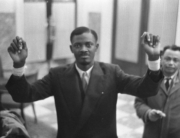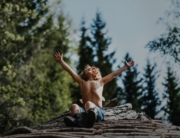
Photographer Chris Hondros in Monrovia, Liberia, as seen in Hondros (Nic Bothma/EPA via Getty Images)
This powerful documentary starts out in the midst of a shoot-out as the late photojournalist Chris Hondros finds himself pinned down by gunfire alongside rebel troops in Liberia. As bullets rain down all around him, his cell phone starts to ring. Nonchalantly, Hondros answers it, assuring whoever is at the other end that he will call them back in half an hour.
Though brief, the sequence makes very clear that this was a man who stayed cool under pressure. What follows does little to undermine this argument. Through interviews with family members, friends, and fellow photographers, we get to know Hondros, who traveled all over the world as a staff photographer for Getty Images. The dangers of his job were obvious to him, but in his view, to do it right meant getting up close to where the action was. As such, he and his camera were present at many of the most important events during the decade leading up to his death.
Director Greg Campbell spends considerable time exploring the places that profoundly affected Hondros’s career, including Liberia and Iraq. In the former, which Hondros visited in 2003 to cover the escalating Second Liberian Civil War, he witnessed plenty of blood and destruction, yet his most famous photograph was of a teenage rebel soldier, whose picture the photojournalist took on a bridge under heavy bombardment. Though the image has an undeniably visceral quality, what makes it truly remarkable is the emotion it captures: in this case, the body language of the subject jumping into the air and his excited expression.
Newspapers all over the world published the photo, and years later, Campbell goes looking for the youth who appeared in it. What he finds isn’t just a grown man but someone whose life was touched by Hondros in remarkable ways. He wasn’t the only one whom the photojournalist stayed in touch with. The implication is that Hondros may have distanced himself emotionally from the dangerous situations he found himself in, but he still felt genuine empathy for those he encountered.
The film delves into its subject’s personal history, looking for events that would have helped form a man drawn to humanity’s dark side. Based on what his mother and close friends have to say, he had an independent streak from a young age, as well as a few daredevil incidents during college that grew his confidence further. Hondros had an easy way of making friends, a yearning to see the larger world, and finely tuned journalistic instincts, which brought him to Pakistan shortly after 9/11 and then a few years later to Iraq to cover the U.S. occupation.
According to former colleagues, he did possess a cocky streak, but no more so than anyone else in his line of work would have. Nevertheless, it becomes apparent that he regularly pushed the boundaries of what was considered safe and may have been slow to learn from his near-fatal experiences. One of the more harrowing recollections from a fellow photojournalist involves Hondros’s decision to drive them across a stretch of Iraq towards Baghdad, which was supposedly under siege. However, they did it without any U.S. Army convoy to protect them, leading to their being ambushed and almost killed.
Yet even if some form of blindness toward risk contributed to Hondros’s demise, it was also integral to what made his work so unique. Campbell constantly cuts from film footage of some pretty dicey situations to photographs taken by Hondros. His laser-like focus allowed the photographer to create visually striking compositions, even when chaos was reigning all around him. If there already isn’t a patron saint of war photographers, this thrilling, ultimately insightful film makes a strong case it should be Hondros, who comes across as one of the best at a very risky profession.






Leave A Comment